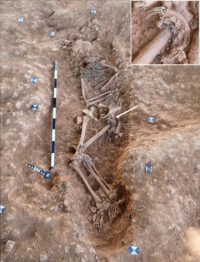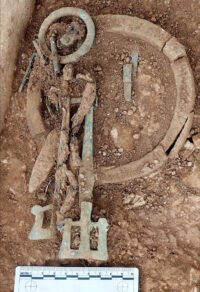 Ivory bag rings discovered in Anglo-Saxon women’s graves have been identified as elephant ivory from contemporary African elephants. A new study published in the Journal of Archaeological Science: Reports has taken a multi-disciplinary approach to examine the ivory and narrow down its origin.
Ivory bag rings discovered in Anglo-Saxon women’s graves have been identified as elephant ivory from contemporary African elephants. A new study published in the Journal of Archaeological Science: Reports has taken a multi-disciplinary approach to examine the ivory and narrow down its origin.
Bag rings have been unearthed in the graves of high-status Anglo-Saxon women in more than 70 cemeteries across England ranging in date from the late 5th to the 7th century A.D. (Ivory rings of around the same date have been found in graves in northern Germany, but far fewer of them than in England.) They are placed at the hip and originally formed the opening of an organic bag worn at the waist along with other objects (tools, knives, girdle hangers).
The rings were smoothed and polished to a high shine and reconstructions based on traces of textile remains indicate the bags hung off the rings so that the ivory was visible. Ivory was a rare and expensive material in early Anglo-Saxon England. Showing it off would have been a conspicuous display of wealth and status.
The source of the ivory for the bag rings has been subject of scholarly debate since they were first discovered in the 19th century. Elephant ivory was not seen as a likely candidate because the trade in African and Asian elephant ivory was believed to have ground to a halt with the fall of the western Roman Empire. Walrus ivory was the dominant source in the later Anglo-Saxon era. Prehistoric mammoth ivory was another possibility. The bag rings are circular and of a larger diameter than the oval, narrow walrus tusks, however, and in several instances, radiocarbon dating of the rings contradicted the mammoth hypothesis.
 Between 2017 and 2019, an excavation of an Anglo-Saxon cemetery in Scremby, Lincolnshire, unearthed 49 inhumations, seven of them containingi the remains of adult females with circular ivory rings at their hips. Researchers have undertaken a multidisciplinary analysis of five of the rings from the Scremby burials in the hopes of pinpointing the origin of the ivory. Radiocarbon dating was employed to confirm the era of the elephantid species, Zooarchaeology by Mass Spectrometry (ZooMS) to distinguish between Asian and African elephantid species and strontium isotope analysis to determine where the animals lived at the time the tusks were formed.
Between 2017 and 2019, an excavation of an Anglo-Saxon cemetery in Scremby, Lincolnshire, unearthed 49 inhumations, seven of them containingi the remains of adult females with circular ivory rings at their hips. Researchers have undertaken a multidisciplinary analysis of five of the rings from the Scremby burials in the hopes of pinpointing the origin of the ivory. Radiocarbon dating was employed to confirm the era of the elephantid species, Zooarchaeology by Mass Spectrometry (ZooMS) to distinguish between Asian and African elephantid species and strontium isotope analysis to determine where the animals lived at the time the tusks were formed.
Radiocarbon dating found that the ivory was roughly contemporaneous with the burials, dating between 428 and 598 A.D. This rules out mammoths, the last of which had died out in Siberia 2,500 years before that. ZooMS identified the Scremby ivories as African elephant. Strontium isotope analysis narrowed down the probable biosphere range of the elephants to the East African Rift Valley in what are now Kenya and Ethiopia.
Armed with this information, researchers believe the elephant ivory was traded by the Kingdom of Aksum in what is now Eritrea. The powerful kingdom had dominated trade in the Red Sea after the fall of Rome, and archaeological evidence of ivory working as late as the 6th century has been found at Aksum sites. The lack of ivory waste at Anglo-Saxon sites indicates the rings were manufactured elsewhere and imported into England. Aksum’s ivory trade declined in the 7th century with the Islamic conquests in North Africa and African ivory was rerouted to China and India where demand was high. In addition to a sharp decline in the supply of elephant ivory rings, the shift in funerary practices as Anglo-Saxons became increasingly Christianized may have decreased demand, a combination that led to disappearance of African elephant ivory bag rings on the archaeological record in the 7th century A.D.